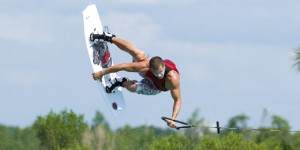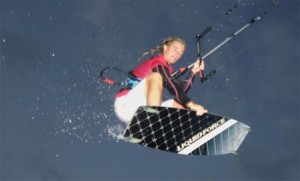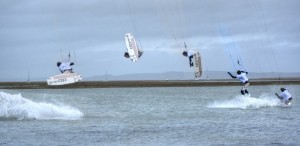Indy Grab
 There are several ways to make your tricks look a bit more stylish. This trick is particularly stretched when you ride or turn you yourself. Another very effective way is to grab on your board. Grabbing the board is certainly borrowed from the surfing and skating. Since neither surfing nor skating bindings are available to make sure that you stay connected to the board, the grab has been found to be the only way to keep the board to their feet when jumping. Over time, many have developed several variants to grab. In Kite surfing we can basically distinguish between jumps, jumps with umbrella support and jumps without umbrella support. The grab without Kite support are much more difficult because you do not have much time to grab on to your board. Although it’s easier with kite supporting grabs it don’t mean that they are less stylish. We show you the easiest start for grabs so you can add a bit of your own kitestyle to them.
There are several ways to make your tricks look a bit more stylish. This trick is particularly stretched when you ride or turn you yourself. Another very effective way is to grab on your board. Grabbing the board is certainly borrowed from the surfing and skating. Since neither surfing nor skating bindings are available to make sure that you stay connected to the board, the grab has been found to be the only way to keep the board to their feet when jumping. Over time, many have developed several variants to grab. In Kite surfing we can basically distinguish between jumps, jumps with umbrella support and jumps without umbrella support. The grab without Kite support are much more difficult because you do not have much time to grab on to your board. Although it’s easier with kite supporting grabs it don’t mean that they are less stylish. We show you the easiest start for grabs so you can add a bit of your own kitestyle to them.
REQUIREMENTS
 To grab your board does not require much skill. You should be sure to control your kite with one hand as you grip the other hand to your board. In addition, you should be reasonably flexible to bend your back. The more flexible your legs and back are, the easier it will be and also look better on the water. In the beginning it will be relatively difficult to find a comfortable position, but gradually it gets easier as you learn to grab the board. As you get more and more comfortable, the more you will be able to stretch one or both legs. So a lot of practice helps a lot.
To grab your board does not require much skill. You should be sure to control your kite with one hand as you grip the other hand to your board. In addition, you should be reasonably flexible to bend your back. The more flexible your legs and back are, the easier it will be and also look better on the water. In the beginning it will be relatively difficult to find a comfortable position, but gradually it gets easier as you learn to grab the board. As you get more and more comfortable, the more you will be able to stretch one or both legs. So a lot of practice helps a lot.
Technically, there are equipment as well as preferences. If you start with high jumps with kite support, we recommend without doubt a kite with a long hang time, so you have plenty of time to grab your board. Also recommended is a medium-large board. The larger the board, the more clumsy and uncontrollable. Many riders prefer a hip harness also which gives you more leeway to twist your body. Seat harnesses are also perfectly fine for practicing this trick.
The Indy Glide is one of the standard tricks. It belongs to the group of loaded jumps. You can make the Indy Glide either hooked or unhooked. In both ways, however, with right conditions you should try to make it without kite support, otherwise it belongs to the group of umbrella supported tricks. It is relatively difficult to make the Indy Glide look stylish, because you do not have much time to perform the trick.
DIRECTIONS AND JUMPING
Ride with medium speed and to keep your kite at 10:30 o’clock. Edge hard to build up tension in the lines. Release the edge of the water and pop out of the water.
Phase of flight and landing
The really important trick to Indy Glide is to go into a kind of forward rotation. So you have to look back over your head with your shoulder and make a half-forward rotation. Release your back hand and grab the bar at the front center of your board. Attempt to straighten your back leg as strong as possible and bring your front knee to your chest. Release the grab and look back in the same direction. Bend your knees to cushion the landing.
